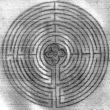



The Parish Church of St George the Martyr, Waterlooville

On a visit to Clivedon in Buckinghamshire, scene of some notoriety in the 1960’s, Rod noticed that a new maze had just been opened. The original had been done in 1874 from a design by Lord Astor. It had fallen into desuetude and this one, in the general shape of a bat’s wings, was formed by 1000 yew trees. It is a great tourist attraction and can be walked with some little difficulty.
The word Labyrinth, meaning in the Greek a ‘Double-
The words Maze and Labyrinth are often used interchangeably, being pathways, openings and dead-
Mazes and labyrinths can be made of many different substances. Locally, for some years, a maze has been constructed from pathways in a maize field. Some are laid on the floor of a building whilst others are carved in turf or done as a mosaic. Indeed, recently in St Cyprien, in southern France, Rod saw advertised a group of fun mazes made out of wood, metal, bamboo and vegetation. It was called “Labyrinthes aux 1000 Fleurs”.
In the cathedral at Chartres Rod has walked barefoot around the labyrinth laid onto the floor. This is intended to be a contemplative journey known as the Chemin de Jerusalem and did have deeply spiritual implications and relief when eventually meditating in the centre (made in the form of a flower).
There is the occasional deception practised by those who have control over labyrinths. The innocent is met outside and invited to enter. When eventually he gets to the goal -
Whatever the reason for making them, mazes and labyrinths are a continued source of fascination, fun and intrigue.
Rod Dawson
Christmas Edition 2011
Mazes and Labyrinths

